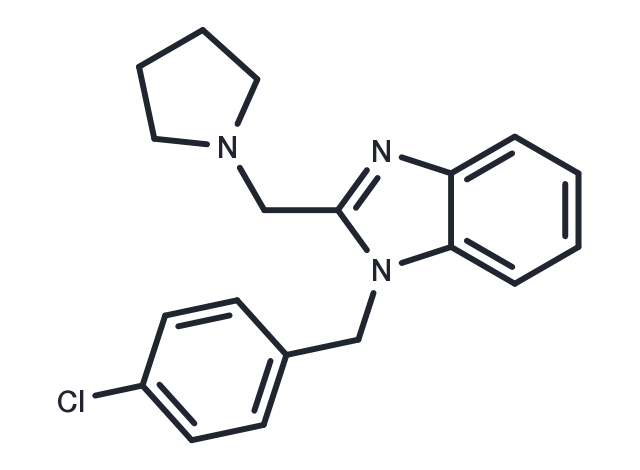Powder: -20°C for 3 years | In solvent: -80°C for 1 year
Clemizole 是一种 H1 组胺受体拮抗剂,可抑制 NS4B 的 RNA 结合和丙型肝炎病毒复制。它也是TRP5通道抑制剂。

| 规格 | 价格/CNY | 货期 | 数量 | |
|---|---|---|---|---|
| 1 mg | ¥ 258 | 现货 | ||
| 5 mg | ¥ 583 | 现货 | ||
| 10 mg | ¥ 869 | 现货 | ||
| 25 mg | ¥ 1,620 | 现货 | ||
| 50 mg | ¥ 2,420 | 现货 | ||
| 100 mg | ¥ 3,580 | 现货 | ||
| 500 mg | ¥ 7,750 | 现货 | ||
| 1 mL * 10 mM (in DMSO) | ¥ 629 | 现货 | ||
| 产品描述 | Clemizole is an H1 histamine receptor antagonist, can inhibit NS4B's RNA binding and hepatitis C virus (HCV) replication. |
| 靶点活性 | H1 (RNA binding by NS4B):24±1 nM |
| 体外活性 | Clemizole hydrochloride is found to inhibit HCV RNA replication in cell culture that is mediated by its suppression of NS4B's RNA binding, with little toxicity for the host cell. The EC50 of Clemizole on the W55R mutant J6/JFH RNA is ~18 μM (2.25 times the EC50 of the wild-type RNA)[1]. Clemizole is a novel inhibitor of TRPC5 channels. Clemizole efficiently blocks TRPC5 currents and Ca2+ entry in the low micromolar range (IC50=1.0-1.3 μM). Clemizole exhibits a six-fold selectivity for TRPC5 over TRPC4β (IC50=6.4 μM), the closest structural relative of TRPC5, and an almost 10-fold selectivity over TRPC3 (IC50=9.1 μM) and TRPC6 (IC50=11.3 μM). Clemizole hydrochloride as a novel blocker of TRPC5 with a half-maximal inhibitory concentration of 1.1 μM. The concentration-response curves confirmed a concentration-dependent block of TRPC5 by Clemizole and revealed an apparent IC50 of 1.1±0.04 μM[2]. |
| 体内活性 | Clemizole hydrochloride has an unexpectedly short plasma half-life (measured at 0.15 hours) which is very rapidly biotransformed into a glucuronide (M14) and a dealkylated metabolite (M12) and into a variety of lesser metabolites in C57BL/6J mice[3]. |
| 细胞实验 | Clemizole hydrochloride is dissolved in DMSO and stored, and then diluted with appropriate media before use[1]. Huh7.5 cells are maintained in DMEM supplemented with 1% L-glutamine, 1% penicillin, 1% streptomycin, 1× nonessential amino acids and 10% FBS. Cell lines are passaged twice weekly after treatment with 0.05% trypsin-0.02% EDTA and seeding at a dilution of 1:5. Subconfluent Huh7.5 cells are trypsinized and collected by centrifugation at 700 g for 5 min. The cells are then washed three times in ice-cold RNase-free PBS and resuspended at 1.5×107 cells/mL in PBS. Wild-type or mutant FL-J6/JFH-5′C19Rluc2AUbi RNA for electroporation is generated by transcription of XbaI linearized DNA templates using the T7 MEGAscript kit, followed by purification (RNA transcription and fluorescent labeling). We mixed 5 μg of RNA with 400 μL of washed Huh7.5 cells in a 2-mm-gap cuvette (BTX) and immediately pulsed (0.82 kV, five 99 μs pulses) with a BTX-830 electroporator. After a 10 min recovery at 25°C, pulsed cells are diluted into 10 mL of prewarmed growth medium. Cells from several electroporations are pooled to a common stock and seeded in 6-well plates (5×105 cells per well). After 24 h, medium is replaced and cells are grown in the presence of serial dilutions of the various inhibitory compounds (e.g., Clemizole hydrochloride) identified in the screen. Seventeen commercially available compounds, out of the 18 identified, are analyzed. Untreated cells are used as a negative control for water-soluble compounds. For compounds (e.g., Clemizole hydrochloride) solubilized in DMSO, untreated cells are grown in the presence of corresponding concentrations of the solvent as a negative control. Medium is changed daily. After 72 h of treatment cells are subjected to an Alamar Blue-based viability assay and luciferase assay. After 72 h of treatment cells are incubated for 3 h at 37°C in the presence of 10% Alamar Blue reagent.Plates are then scanned and fluorescence is detected by using FLEXstation II 384. Depending on the inhibitory compound's solvent (e.g., Clemizole hydrochloride), water or DMSO, signal is normalized relatively to untreated samples or samples grown in the presence of DMSO, respectively[1]. |
| 别名 | 克立咪唑, 吡咯咪唑 |
| 分子量 | 325.84 |
| 分子式 | C19H20ClN3 |
| CAS No. | 442-52-4 |
Powder: -20°C for 3 years | In solvent: -80°C for 1 year
DMSO: 22.5 mg/mL (69.05 mM), Sonification is recommended
| 可选溶剂 | 浓度 体积 质量 | 1 mg | 5 mg | 10 mg | 25 mg |
| DMSO | 1 mM | 3.069 mL | 15.345 mL | 30.6899 mL | 76.7248 mL |
| 5 mM | 0.6138 mL | 3.069 mL | 6.138 mL | 15.345 mL | |
| 10 mM | 0.3069 mL | 1.5345 mL | 3.069 mL | 7.6725 mL | |
| 20 mM | 0.1534 mL | 0.7672 mL | 1.5345 mL | 3.8362 mL | |
| 50 mM | 0.0614 mL | 0.3069 mL | 0.6138 mL | 1.5345 mL |
对于不同动物的给药剂量换算,您也可以参考 更多...
请在以下方框中输入您的动物实验信息后点击计算,可以得到母液配置方法和体内配方的制备方法: 比如您的给药剂量是10 mg/kg,每只动物体重20 g,给药体积100 μL,一共给药动物10 只,您使用的配方为5% DMSO+30% PEG300+5% Tween 80+60% ddH2O。那么您的工作液浓度为2 mg/mL。
母液配置方法:2 mg 药物溶于 50 μL DMSO (母液浓度为 40 mg/mL), 如您需要配置的浓度超过该产品的溶解度,请先与我们联系。
体内配方的制备方法:取 50 μL DMSO 主液,加入 300 μL PEG300, 混匀澄清,再加 50 μL Tween 80,混匀澄清,再加 600 μL ddH2O, 混匀澄清。
您可能有的问题的答案可以在抑制剂处理说明中找到,包括如何准备库存溶液,如何存储产品,以及基于细胞的分析和动物实验需要特别注意的问题。
Clemizole 442-52-4 GPCR/G Protein Immunology/Inflammation Microbiology/Virology Neuroscience Proteases/Proteasome HCV Protease Histamine Receptor TRP Channel inhibit 克立咪唑 吡咯咪唑 Hepatitis C virus Transient receptor potential channels HCV Inhibitor inhibitor
